Featured Application
This study was about a new test instrument to test and evaluate the bonding ability between basalt fiber bundles and the asphalt mortar. It could be used as a verification tool to exam the quality of the basalt fibers which are going to be used in the road construction. Because different manufacturers use their own coupling agents to modify the basalt fibers and have different characteristics of the manufacturing process, this could result in the differences of the quality of basalt fiber product. The test results of this instrument might also be adopted in other studies, e.g., to predict the properties of basalt fiber reinforced asphalt composite materials, etc.
Abstract
The bonding ability between basalt fiber bundle and asphalt mortar has a great influence on the properties of basalt fiber reinforced asphalt mixtures, yet the studies about the bonding between them is very limited. In this paper, a new test instrument called fiber-asphalt pulling machine and a new index called the nominal bonding stress (NBS) were designed and adopted to test and reveal the bonding between basalt fiber bundle and asphalt mortar. The procedures and rationality analysis of this new experiment was specified in this paper. In order to verify the reliability of the NBS index, the NBS values derived from this new test method and the rheological property indexes values of asphalt mortar under different powder–cement ratios were adopted to analyze the correlation between them. Two kinds of basalt fibers produced by two different manufacturers were adopted to conduct the parallel experiment. The results show that the nominal bonding stress between basalt fiber and asphalt mortar derived from this new test has a great correlation with the rheological properties of asphalt mortar, which also proves the credibility of this new test method and the NBS index.
1. Introduction
Researchers around the world have been using and developing the existing evaluation indexes of asphalt and asphalt mixtures [,,] to evaluate their performance and better guide the design of the asphalt pavement. The softening point, penetration index, rheological properties of asphalt are adopted to evaluate the performance of asphalt material [,,]. Moreover, the Marshall stability, four-point bending fatigue test, Semi-circle bending (SCB) test, etc. are used to assess the performance of the asphalt mixtures [,,]. Basalt fiber is a kind of eco-friendly fiber made from basalt stone and it has good mechanical properties, stability, and thermal insulation, and so on [,]. Therefore, many researchers have used basalt fibers in various kind of research fields. For instance, the magnesium phosphate cement, the concrete and the aerospace research field etc. [,,]. Ahmad et al. []. mentioned that basalt fiber is a potential candidate in replacing the glass fiber and the steel fiber to reinforce the cementitious materials due to its low cost and superior tensile strength etc. Sun et al. []. conducted studies about basalt fiber reinforced concrete, and the results show that basalt fiber has a good reinforcing effect on the concrete and the fiber content and length will influence the property of concrete. Gautam et al. []. studied an optimization method to cut basalt fiber into different shapes to be better used in various fields such as the aerospace and automotive field. Basalt fiber is also used in the road engineering research field. Basalt fiber reinforced asphalt mixtures are now very popular due to its good performance [,,], such as the high and low temperature properties and the water stability etc. Wang et al. []. found that basalt fiber could reinforce the splitting tensile strength etc. before and after the freeze-thaw cycles. Li et al. []. concluded that basalt fiber could improve the adaptability of the asphalt mixtures in low temperatures. Zhao et al. []. conducted researches about asphalt mixtures reinforced by basalt fiber, lignin fiber, and polyester fiber. Their results showed that basalt fiber could improve the high and low temperature properties of asphalt mixtures. The basalt fiber used in the basalt fiber reinforced asphalt mixtures are in the form of a bundle, consisting of hundreds of single basalt fibers with a diameter at micron level. There is no doubt that the bonding ability between the basalt fiber bundle and the asphalt mortar can well reflect the reinforcing effect of the basalt fibers in the asphalt mixtures. This is because the bonding ability will influence the effectiveness of the basalt fibers bearing some part of the inner stress [] inside the asphalt mortar or mixtures. However, the existing tests are mainly about the performance of the asphalt or the asphalt mixtures, the test about the bonding ability between the basalt fiber bundle and the asphalt mortar is very limited. Yu et al. adopted the water contact angle test, SEM test and the FTIR test to reveal the adhesion between basalt fiber and asphalt []. Yet, these tests cannot quantitatively reflect the bonding between the basalt fiber and asphalt material. Many other studies adopted the similar method to reveal the bonding between basalt fiber and asphalt or mixture. Generally, SEM was designed to see the distribution of basalt fiber inside the asphalt mixture, and this method could just explain the connection or bonding status between the basalt fiber and the asphalt and it was just a qualitative analysis of the bonding between basalt fiber and asphalt. FTIR test could reveal the chemical functional group of the surface of the basalt fiber and the chemical composition of asphalt, and FTIR test could also not get a quantification index about the bonding between them. Therefore, it is necessary to develop a new kind of instrument to test the bonding between the basalt fiber bundle and the asphalt mortar to better reveal the actual bonding status between the basalt fiber bundles and the asphalt mortar and also get an index that could quantitatively reflect the bonding between basalt fiber and asphalt material, because a quantitative index could be used to reflect the bonding ability between basalt fiber and asphalt material more clearly.
This paper aims to introduce a new test instrument [] and method to test the bonding ability between basalt fiber bundle and asphalt mortar using a new instrument called the fiber-asphalt pulling machine, and a new index reflecting the bonding between them called nominal bonding stress (NBS) was proposed in this paper. However, the reliability of this new test method and index need to be verified. The property of the asphalt or asphalt mortar are of great significance on the performance of the asphalt mixtures or the asphalt pavement []. Studies show that the rheological property of asphalt has a great correlation with the performance of asphalt mixture [,,], and the rheological property indexes are much more accurate than the traditional evaluation indexes such as the softening point and the penetration value of asphalt []. When the basalt fiber type was fixed, the bonding ability between basalt fiber and asphalt mortar was mainly affected by the property of asphalt mortar. Therefore, the rheological property indexes of the asphalt mortar were chosen to study the correlation between them and the NBS index to prove the credibility of this new test method and the corresponding calculation equation of NBS index.
The NBS index is a very important index and it can also represent the viscosity of the asphalt mortar to some extent when the fibers are the same. Because when the fibers are the same, the adhesion between the fiber and asphalt mortar will be affected all by the properties of the asphalt mortar, especially the viscosity of the asphalt mortar. In this paper, two kinds of continuous basalt fibers provided by two different manufacturers were adopted to test the NBS and the asphalt mortar under four kinds of different powder-cement ratios. The reason for using two kinds of basalt fibers in the tests and analysis was to conduct the parallel testing to further verify the validity of this method and the NBS index. The rheological properties of the asphalt mortar under different powder cement ratios were also tested using the dynamic shear rheometer. The corresponding test data of the nominal bonding stress (NBS) obtained using the fibers provided by two different manufacturers were then used to study the correlation between them and the rheological property indexes of the asphalt mortar separately to verify the reliability of this new method.
2. Materials and Methods
2.1. Materials
2.1.1. Asphalt
SBS modified asphalt used in this paper was provided by Jiangsu Tiannuo Road Materials Technology Co., Ltd., Zhenjiang, China. The properties of it provided by the manufacturer are shown in Table 1. The tests were carried out according to the Standard Test Methods of Bitumen and Bituminous Mixtures for Highway Engineering (JTG E20-2011) [].

Table 1.
Properties of SBS modified asphalt.
2.1.2. Mineral Powder
The mineral powder (Figure 1) was made from limestone and was provided by Dingbang mineral powder Co., Ltd., Zhenjiang, China. The property indexes provided by the manufacturer are listed in Table 2, the tests were conducted according to the Test methods of Aggregate for Highway Engineering (JTG E42-2005) [] and the indexes are in accordance with the Technical specification for construction of highway asphalt pavement (JTG F40-2004) []. It can be seen from Table 2 that the size of the mineral powder was smaller than 0.6 mm, and therefore a combination of asphalt and the fine particles (mineral powder) was called asphalt mortar [,].
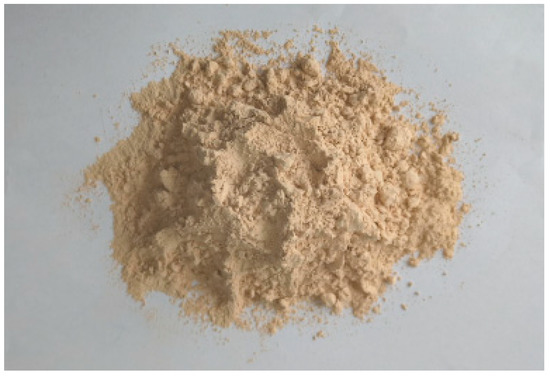
Figure 1.
Mineral powder.

Table 2.
Properties of mineral powder.
2.1.3. Continuous Basalt Fiber
The continuous basalt fibers (Figure 2) used in the fiber-asphalt pulling test were provided by the Jiangsu Tianlong Basalt Continuous Fiber Co., Ltd., Yizheng, China (1#) and the Jilin Tongxin Basalt Technology Co., Ltd., Tonghua, China (2#). The single bunch of the 1# and 2# continuous basalt fiber consists of 400 single fibers with a diameter at micron level. The parameters and properties of the continuous basalt fibers provided by the manufacturers are shown in Table 3. The organic coupling agent was adopted to modify the surface of the basalt fiber in the manufacturing process to make it connect better with the asphalt, because basalt is a kind of inorganic material and asphalt is a kind of organic material. Different manufactures have their own coupling agent which will result in the difference of the properties of the basalt fiber product.
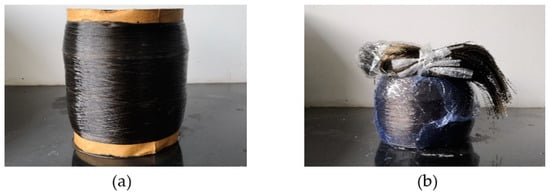
Figure 2.
Continuous basalt fiber: (a) 1# (provided by the Jiangsu Tianlong Basalt Continuous Fiber Co., Ltd., Yizheng, China); (b) 2# (provided by the Jilin Tongxin Basalt Technology Co., Ltd., Tonghua, China).

Table 3.
Properties of basalt fiber.
2.2. Experimental Design
The experimental design was illustrated in the flowchart and is shown in Figure 3. The goal of this experiment design is to obtain an index called nominal bonding stress (NBS) to reflect the bonding ability between basalt fiber and asphalt mortar, and to verify the validity of NBS by conducting the correlation analysis between the NBS value and the rheological property values collected from the fiber-asphalt pull out test and the rheological properties test under different powder–cement ratios.
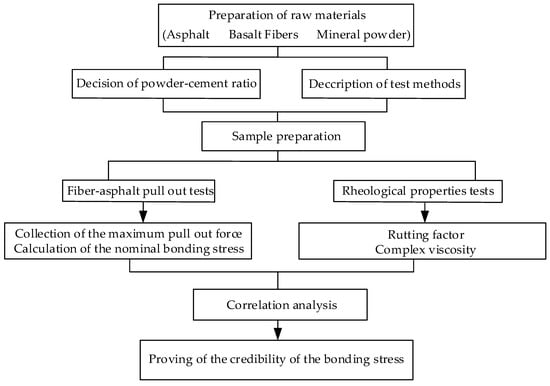
Figure 3.
Flowchart of the experiments.
2.3. Test Methods
2.3.1. Decision of Powder-Cement Ratio
In order to make the test results of the fiber-asphalt pulling test more reliable, this section chose to calculate the powder-cement ratio using the equations specified in the Technical specification for construction of highway asphalt pavement (JTG F40-2004) []. The parameters of several commonly used mixtures, such as SUP-13, SUP-20, and SUP-25 tested in the former researches of our group, were adopted to calculate the powder-cement ratio values, and the SUP-13, SUP-20, and SUP-25 name method was illustrated in a study conducted by Lou et al. []. The equations of the calculation are listed in Equations (1)–(3). The calculation process of the powder-cement ratios of several commonly used mixtures are listed in Table 4. Considering the calculation results, the powder–cement ratios adopted in the fiber-asphalt pulling tests and the rheological tests were set as 0.8, 1.0, 1.2, and 1.4.

Table 4.
Calculation table of powder binder ratio of different gradations.
In the equations, FB is the powder-cement ratio (the ratio between the mineral powder and the asphalt); P0.075 is the passing rate of 0.075 mm screen mesh in the aggregate gradation (water washing method), %; Pbe is the effective asphalt content in asphalt mixture, %; Pb is the asphalt content in the mixture, %; Pba is the proportion of asphalt binder absorbed by the aggregate in asphalt mixture, %; γse is the effective relative density of the aggregate; γsb is the synthetic bulk volume relative density; γb is the relative density of asphalt (25 °C).
2.3.2. Asphalt Mortar Sample Preparation
The asphalt mortar samples were prepared by blending the mineral powder and the asphalt together according to the powder-cement ratio. Asphalt was heated and kept at 175 °C and then the mineral powder was added into the asphalt. The mix of the asphalt and the mineral powder was blended using the asphalt stirring machine for 30 min and the stirring speed was 2000 rpm. Then the asphalt mortar was ready for the corresponding tests.
2.3.3. Fiber-Asphalt Pulling Test
The fiber-asphalt pulling machine (Figure 4) was designed by Yangzhou University, China. The test parameters were controlled by a control panel (Figure 5), and different test parameters such as test temperature, pulling speed can be edited through this control panel. The temperature range of this instrument is 10 °C to 80 °C, the capacity of the load cell is 30 N, the sampling rate is 2 times per second, and the minimum unit of the displacement sensor is 1 mm. According to the previous research of this instrument [], the test data was the stablest (the variation of the test data was the lowest) when the test temperature was 40 °C, the pulling speed was 10 mm/min and the length of the fiber being buried into the asphalt mortar was 20 mm. In order to make the test data more reliable, the test will be conducted three times under the same test parameters, and the test will be re-conducted when the deviation between the test result of a single test and the average value was more than 10%. The average value was adopted as the final test results of the pulling force.
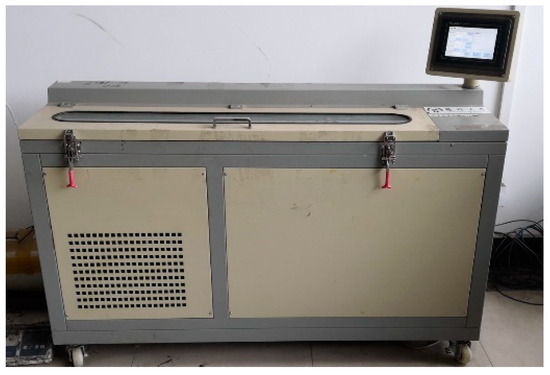
Figure 4.
Fiber-asphalt puling machine.

Figure 5.
Control panel.
The process of the test was listed as follows: (1) Pour the asphalt mortar into the separate part of the mold to the half of its height (Figure 6a). (2) Make a mark at the fiber 20 mm away from the end of the fiber, put the continuous fiber into the asphalt mortar, and put two small pieces of paper onto the surface of the surface of the gap in the mold (Figure 6b). (3) Pour the rest of the asphalt mortar into the mold and make it cool at room temperature to prepare the test (Figure 6c). (4) Put the mold into the chamber of the instrument (Figure 6d), and adjust the location of the fixer of the fiber (marked by the red arrow) to make it parallel to the length direction of the fiber, and fix the fiber on the fixer by wrapping the fiber around the fixer. (5) Close the chamber and set the temperature as 40 °C to heat the specimen at 40 °C for 1 h. (6) Record the maximum pulling force in the test and using the nominal bonding stress calculation equation to calculate the NBS index.
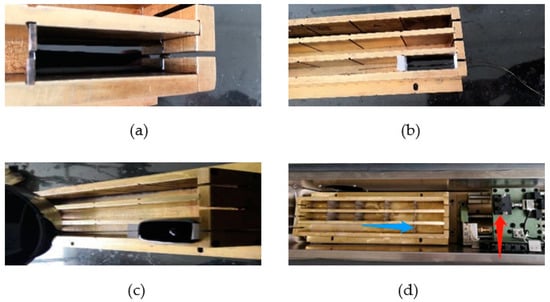
Figure 6.
Continuous basalt fiber: (a) Step 1; (b) Step 2; (c) Step 3; (d) Step 4.
The continuous basalt fiber consists of 400 single basalt fibers with the diameter of 16 μm or 17 μm, considering the two kinds of continuous basalt fibers used in this paper. As it can be seen from Figure 7, the asphalt mortar does not fully soak into the fiber. This phenomenon can be explained in two ways. Firstly, in the sample preparation process, the outer side of the asphalt mortar sample will get cold first, which could create the temperature stress inside the asphalt mortar sample. The direction of the temperature stress was from the inner side to the outer side, because the outer side will get cold first. The draft of the distribution of the temperature stress is illustrated in Figure 8, and this temperature stress could induce the inner stress expanding from inside the fiber (as is shown in Figure 7). The main causes of this stress were the temperature difference and the shrinkage and expansion of the asphalt mortar caused by it. Secondly, the 400 single micron level basalt fibers overlay with each other and they were connected and touched with each other by the coupling agent on the surface of the single tiny fibers. Therefore, the distribution of asphalt mortar inside the fiber was also affected by the blocking effect of the overlaying of the micron level fibers. The temperature force will disappear when the sample as a whole reaches the room temperature. At the same time, the distribution of the asphalt mortar inside the fiber is fixed until conducting the pulling test.

Figure 7.
Analysis of the asphalt distribution inside the fiber.

Figure 8.
Temperature stress.
Due to the fact that the asphalt material is viscous [,,], it is easy to understand that the maximum pulling force would appear in the pulling process when all the length of the fiber (20 mm) were participating in the pulling, because the viscous property of asphalt mortar could make it still connect with the fiber in the pulling process until the maximum pulling force appeared. After the maximum pulling force appeared, some part of the asphalt mortar connected with the fiber started to broke (reached the viscosity property limit of the asphalt mortar), which will result in the decrease of the pulling force. The condition at this moment is illustrated in Figure 9. As can be seen in Figure 9, due to the of the viscosity of asphalt material (asphalt mortar), when displacement of the pulling process reaches the adhesion ability limit of the asphalt mortar lying on the surface of the fiber, the maximum value of the pulling force in the pulling process occurs. Therefore, the nominal bonding stress between the basalt fiber and the asphalt mortar can be calculated using Equation (4), where τmax is the nominal bonding stress, Fmax is the maximum pulling force and S is the touching area between the fibers and the asphalt mortar.

Figure 9.
Pulling process when the maximum pulling force occurs.
However, considering the asphalt mortar distribution inside the fiber, the touching area (S) between the micron level basalt fibers and the asphalt mortar used in the equation of the nominal bonding stress need to be reduced using a certain reduction coefficient. The actual touching area is hard to calculate, therefore, the revised touching area was put forward using Equations (5) and (6). When the overall area of the fiber section was the same, the area of the touching area would be reduced when the overall area of the 400 single micron fibers were assumed as a rectangle area, as is shown in Figure 10. In these two equations, w is the width of the fiber (the unit is μm); h is the revised height of the rectangle; d is the diameter of the micron level basalt fiber; L is 20,000 μm (20 mm) in this paper.
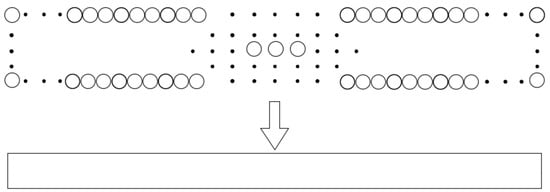
Figure 10.
Reduction of the bonding area.
It should also be mentioned that even though the revised touching area between the fibers and asphalt mortar is not accurate enough, using the revised touching area to calculate the nominal bonding stress was more accurate than using the overall area of the micron basalt fibers. The goal of this paper was to verify the reliability of this new test method and the nominal bonding stress between the basalt fiber and the asphalt mortar, therefore the error of the nominal bonding stress conducted in this paper could be revised using the revising coefficient in other different studies, such as using the nominal bonding stress to predict the strength of the fiber reinforced asphalt mortar or asphalt mixtures. The main contribution of this nominal bonding stress calculation and test method was to provide a relatively stable index revealing the bonding between the basalt fiber bundle and the asphalt mortar. To verify the validity of the nominal bonding stress calculated in this paper, the correlation between the nominal bonding stress (using a fixed kind of basalt fiber) and the rheological properties of the asphalt mortar was studied in the later section.
2.3.4. Rheology Performance Test
The rheological properties [,] of the asphalt mortar with different powder-cement ratios were tested using the dynamic shear rheometer (Figure 11) produced by the Malvern Instruments Co., Ltd., Malvern, UK. The test parameters were set according to ASTM D7175 []. The gap value was 1000 μm and the strain was controlled as 1%. The diameter of the parallel plate was 25 mm and the sine wave load was applied to the test sample during the test. The temperature sweep test was adopted to test the rutting factor and the complex viscosity of the test samples. Zhao [] found that the average maximum temperature in the pavement layers in Jiangsu province was 59.73 °C (in July). Therefore, this paper adopted 40 °C, 46 °C, 52 °C, and 58 °C as the test temperature to test the high temperature rheological properties of asphalt mortar.

Figure 11.
Dynamic shear rheometer.
3. Results and Discussion
3.1. Bonding Strength
The average maximum pulling force collected from the test is listed in Table 5, and the corresponding nominal bonding stress calculated using Equations (4)–(6) is shown in Table 6.

Table 5.
Average maximum pulling force.

Table 6.
Results of nominal bonding stress.
It can be inferred from Table 5 and Table 6 that the maximum pulling force and the nominal bonding stress was positively correlated with the powder-cement ratio. The difference between the nominal bonding stress of 1# fiber and 2# fiber when the powder cement ratio was 0.8, 1.0, 1.2, and 1.4 was about 5.6%, 1.0%, 13.1%, and 11.0% that of 2# fiber. The difference was mainly caused by the coupling agent [] on the basalt fibers because the main difference of the chemical composition of the two fibers are the coupling agent on the fiber surface. The coupling agent acts as the bridge to connect the asphalt mortar and the basalt fiber and to disperse the stress in the asphalt mixtures from the asphalt material to the basalt fiber, making basalt fibers absorb the stress in the asphalt mixture more effectively. This is because the coupling agent of basalt fiber such as silane is a kind of organic material [,] and the original basalt fiber is inorganic because it is a mineral fiber made from nature basalt stone []. Thus, the connection between them is not good. Considering the fact that the asphalt is a kind of organic material [], it is wise to adopt the coupling agent to modify the original basalt fiber to make it connect better with the asphalt material. Therefore, it is reasonable to adopt the nominal bonding stress to evaluate the bonding between the basalt fiber and the asphalt fiber because this is a very significant index. In the later section, the correlation between the nominal bonding stress and the rheological indexes was analyzed to verify the reliability of the nominal bonding stress calculated using this method.
3.2. Rheological Properties
It can be seen from Figure 12 and Figure 13 that with the increase of the powder cement ratio, the rutting factor and the complex viscosity of the asphalt mortar keep increasing. This is mainly because that when the powder cement ratio increase, there will be more mineral powder absorbing the asphalt, forming the asphalt film [] on its surface, the mineral powder can connect with the asphalt tighter through the asphalt film. This will make the whole mechanical property of the asphalt mortar better, because the mineral powder could participate more in the bearing of the stress during the test process. Generally, the impact of the powder cement ratio on the two rheological indexes increases when the temperature decreases.
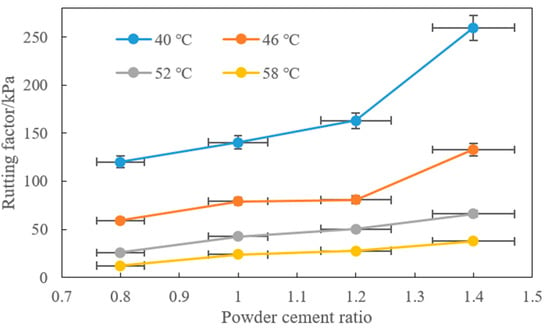
Figure 12.
Rutting factor.
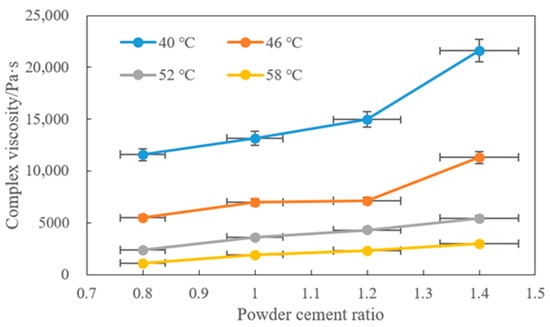
Figure 13.
Complex viscosity.
3.3. Correlation Analysis
In this section, the data of the calculated nominal bonding stress between the same kind of fiber (1# fiber or 2# fiber) and the asphalt mortar with different powder cement ratios were collected to do the correlation analysis with the test results of the rutting factor and the complex viscosity. It should be mentioned that the rheological indexes were tested under four kinds of temperatures (40 °C, 46 °C, 52 °C, 58 °C). In order to find at which temperature the nominal bonding stress has the best correlation with the rheological indexes, this section adopted the rheological tests results at 40 °C, 46 °C, 52 °C, and 58 °C to conduct the correlation analysis between the rheological indexes and the nominal bonding stress. The fiber asphalt pulling test was carried out at 40 °C. Therefore, this section also aims to verify the reliability of the test results of the nominal bonding stress. Because if the test results of the fiber asphalt pulling test and the nominal bonding stress are accurate enough, the coefficient of determination (R2) of the correlation analysis results will be bigger than the other situations when the temperatures of the rheological test is at 40 °C (the same temperature as the test temperature of the fiber asphalt pulling test).
It can be concluded from Figure 14 and Figure 15 that, when the fibers are the same, the correlation analysis results show that the coefficient of determination (R2) increases when the temperature of the rutting factor and the complex viscosity decrease, and the R2 value is the biggest when the test temperature of the two rheological indexes is 40 °C (the same temperature as the test temperature of the fiber asphalt pulling test), and the R2 values are all bigger than 0.95 in this situation. This phenomenon shows that the nominal bonding stress calculated from the test results of the newly developed fiber asphalt pulling test has a good correlation with the rheological properties of the asphalt mortar, because higher R2 value means better correlation between these two indexes. Moreover, the reliability of the nominal bonding stress derived from this new test is credible.
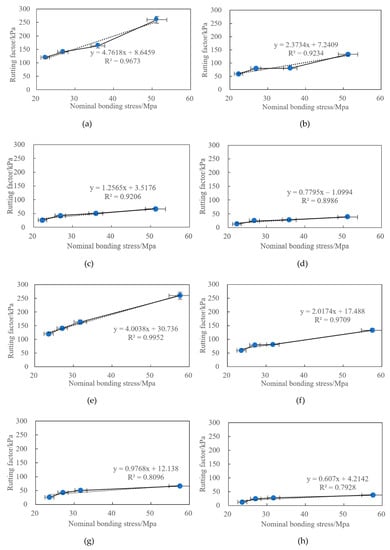
Figure 14.
Correlation between bonding strength and rutting factor: (a) 40 °C-1#; (b) 46 °C-1#; (c) 52 °C-1#; (d) 58 °C-1#; (e) 40 °C-2#; (f) 46 °C-2#; (g) 52 °C-2#; (h) 58 °C-2#.
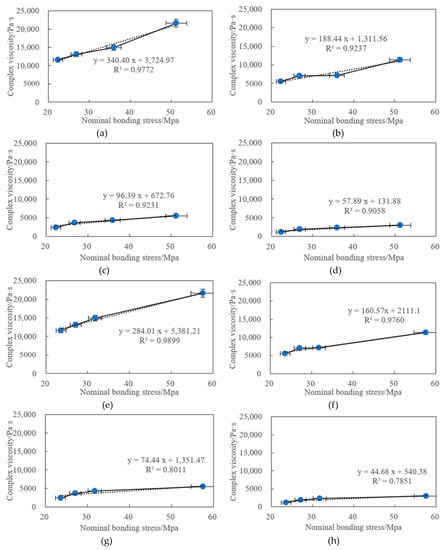
Figure 15.
Correlation between bonding strength and complex viscosity: (a) 40 °C-1#; (b) 46 °C-1#; (c) 52 °C-1#; (d) 58 °C-1#; (e) 40 °C-2#; (f) 46 °C-2#; (g) 52 °C-2#; (h) 58 °C-2#.
Considering that the cost of the fiber asphalt pulling test or machine are far lower than the rheological test or instrument and that this newly developed test can both reveal the rheological property of the asphalt mortar to some extent and reveal the bonding between basalt fiber and the asphalt mortar in the basalt fiber reinforced asphalt composite materials, the nominal bonding stress between basalt fiber and asphalt mortar is reliable and accurate enough. In further studies, the nominal bonding stress (NBS) index might also be used to predict or give a prediction equation of the basalt fiber reinforced asphalt composite materials. The prediction equation might be based on the NBS index, the content of basalt fibers, the length of basalt fibers, and the properties of the asphalt composite material without basalt fiber etc. The nominal bonding stress calculated from this test can also be adopted into other studies, such as the finite element and discrete element analysis of the basalt fiber reinforced asphalt or asphalt mixtures, and in these studies, the fiber shape parameters and the connection area between the fiber bundle and the asphalt mortar etc. could also be adjusted according to the further studies using the ESEM test or other tests.
4. Conclusions
After conducting the fiber asphalt pulling test, the rheological test, and the correlation analysis between the nominal bonding stress and the rheological indexes values, the conclusions were listed below:
- The increase of the powder cement ratio makes the maximum pulling force and the calculated nominal bonding stress bigger. The basalt fiber type influences the nominal bonding stress between the asphalt mortar and basalt fiber. For instance, the difference between NBS value of 1# fiber and 2# fiber was about 13.1% that of 2# fiber when the powder-cement ratio was 1.2.
- The rutting factor and the complex viscosity will increase when the powder cement ratio increases. The powder cement ratio could affect the rheological properties more when the temperature decrease.
- The NBS index derived from the new fiber asphalt pulling test has a great correlation with the rutting factor and the complex viscosity. The correlation between them are the best when the test temperatures of the rheological tests and the fiber pulling tests are the same, which verified the validity of this method and the NBS index.
- The nominal bonding stress calculated from the test results of this new instrument can be adopted to verify the property of the basalt fiber products when the basalt fibers are going to be used in the asphalt pavement or other asphalt materials.
Author Contributions
Conceptualization, X.W. and A.K.; methodology, X.W. and A.K.; software, X.W.; validation, A.K., P.X., and Z.W.; formal analysis, X.W.; investigation, X.W. and B.W.; data curation, X.W. and B.W.; writing—original draft preparation, X.W.; writing—review and editing, A.K.; visualization, X.W.; supervision, A.K.; project administration, A.K.; funding acquisition, A.K. All authors have read and agreed to the published version of the manuscript.
Funding
This research was funded by the National Natural Science Foundation of China (Grant Number 51578481), Jiangsu Science and Technology Project (Grant Number SBE2017740635), Yangzhou University International Academic Exchange Fund (Grant Number 20190212) and Yangzhou University Scientific Research and Innovation Program (Grant Number YKYCX20_008).
Acknowledgments
The authors want to appreciate the Yangzhou University Test Center for buying and offering some of the test instruments and materials, and also want to thank Applied Sciences Editorial Office for their patient editing and support during the writing of this manuscript.
Conflicts of Interest
The authors declare no conflict of interest.
References
- Gao, Y.; Geng, D.; Huang, X.; Li, G. Degradation evaluation index of asphalt pavement based on mechanical performance of asphalt mixture. Constr. Build. Mater. 2017, 140, 75–81. [Google Scholar] [CrossRef]
- Sun, D.; Lin, T.; Zhu, X.; Cao, L. Calculation and evaluation of activation energy as a self-healing indication of asphalt mastic. Constr. Build. Mater. 2015, 95, 431–436. [Google Scholar] [CrossRef]
- Gu, F.; Chen, C.; Yin, F.; West, R.C.; Tylor, A. Development of a new cracking index for asphalt mixtures using indirect tensile creep and strength test. Constr. Build. Mater. 2019, 225, 465–475. [Google Scholar] [CrossRef]
- Xing, X.; Pei, J.; Li, R.; Tan, X. Effect and mechanism of calcium carbonate whisker on asphalt binder. Mater Res. Express. 2019, 6, 055306. [Google Scholar] [CrossRef]
- Lei, Y.; Wang, H.; Chen, X.; Yang, X.; You, Z.; Dong, S.; Gao, J. Shear property, high-temperature rheological performance and low-temperature flexibility of asphalt mastics modified with bio-oil. Constr. Build. Mater. 2018, 174, 30–37. [Google Scholar] [CrossRef]
- Kou, C.; Wu, X.; Xiao, P.; Liu, Y.; Wu, Z. Physical, Rheological, and Morphological Properties of Asphalt Reinforced by Basalt Fiber and Lignin Fiber. Materials 2020, 13, 2520. [Google Scholar] [CrossRef]
- Ge, D.; Yan, K.; Ye, F.; Zhao, X. The laboratory performance of asphalt mixture with Amorphous poly alpha olefins (APAO) modified asphalt binder. Constr. Build. Mater. 2018, 188, 676–684. [Google Scholar] [CrossRef]
- Wang, H.; Yang, J.; Liao, H.; Chen, X. Electrical and mechanical properties of asphalt concrete containing conductive fibers and fillers. Constr. Build. Mater. 2016, 122, 184–190. [Google Scholar] [CrossRef]
- Falchetto, A.C.; Moon, K.H.; Wang, D.; Riccardi, C.; Wistuba, M.P. Comparison of low-temperature fracture and strength properties of asphalt mixture obtained from IDT and SCB under different testing configurations. Road Mater. Pavement 2018, 19, 591–604. [Google Scholar] [CrossRef]
- Zheng, Y.; Cai, Y.; Zhang, G.; Fang, H. Fatigue property of basalt fiber-modified asphalt mixture under complicated environment. J. Wuhan Univ. Technol. 2014, 29, 996–1004. [Google Scholar] [CrossRef]
- Cheng, Y.; Yu, D.; Gong, Y.; Zhu, C.; Tao, J.; Wang, W. Laboratory evaluation on performance of eco-friendly basalt fiber and diatomite compound modified asphalt mixture. Materials 2018, 11, 2400. [Google Scholar] [CrossRef]
- Ahmad, M.R.; Chen, B.; Yu, J. A comprehensive study of basalt fiber reinforced magnesium phosphate cement incorporating ultrafine fly ash. Compos. Part B Eng. 2019, 168, 204–217. [Google Scholar] [CrossRef]
- Sun, X.; Gao, Z.; Cao, P.; Zhou, C. Mechanical properties tests and multiscale numerical simulations for basalt fiber reinforced concrete. Constr. Build. Mater. 2019, 202, 58–72. [Google Scholar] [CrossRef]
- Gautam, G.D.; Mishra, D.R. Firefly algorithm based optimization of kerf quality characteristics in pulsed Nd: YAG laser cutting of basalt fiber reinforced composite. Compos. Part B Eng. 2019, 176, 107340. [Google Scholar] [CrossRef]
- Wang, W.; Cheng, Y.; Ma, G.; Tan, G.; Sun, X.; Yang, S. Further investigation on damage model of eco-friendly basalt fiber modified asphalt mixture under freeze-thaw cycles. Appl. Sci. 2019, 9, 60. [Google Scholar] [CrossRef]
- Li, Z.; Shen, A.; Wang, H.; Guo, Y.; Wu, H. Effect of basalt fiber on the low-temperature performance of an asphalt mixture in a heavily frozen area. Constr. Build. Mater. 2020, 253, 119080. [Google Scholar] [CrossRef]
- Zhao, H.; Guan, B.; Xiong, R.; Zhang, A. Investigation of the performance of basalt fiber reinforced asphalt mixture. Appl. Sci. 2020, 10, 1561. [Google Scholar] [CrossRef]
- Qin, X.; Shen, A.; Guo, Y.; Li, Z.; Lv, Z. Characterization of asphalt mastics reinforced with basalt fibers. Constr. Build. Mater. 2018, 159, 508–516. [Google Scholar] [CrossRef]
- Xiang, Y.; Xie, Y.; Long, G. Effect of basalt fiber surface silane coupling agent coating on fiber-reinforced asphalt: From macro-mechanical performance to micro-interfacial mechanism. Constr. Build. Mater. 2018, 179, 107–116. [Google Scholar] [CrossRef]
- Wu, Z.; Zhou, J.; Xiao, P.; Pan, X.; Li, B. Development and Application of Asphalt Mortar Fiber Drawing Test Machine. China Mod. Educ. Equip. 2020, 3, 12–14. (In Chinese) [Google Scholar]
- Behnood, A.; Gharehveran, M.M. Morphology, rheology, and physical properties of polymer-modified asphalt binders. Eur. Polym. J. 2019, 112, 766–791. [Google Scholar] [CrossRef]
- Guo, D.D. Impact of Rheological Properties of Fiber Asphalt Mortar on Mixture Road Performance. In Advanced Materials Research; Trans Tech Publications Ltd.: Zurich, Switzerland, 2013; Volume 734, pp. 2287–2291. [Google Scholar]
- Morea, F.; Agnusdei, J.O.; Zerbino, R. The use of asphalt low shear viscosity to predict permanent deformation performance of asphalt concrete. Mater Struct. 2011, 44, 1241–1248. [Google Scholar] [CrossRef]
- Mirzaaghaeian, E.; Modarres, A. Rheological properties of bituminous mastics containing chemical warm additive at medium temperatures and its relationship to warm mix asphalt fatigue behavior. Constr. Build. Mater. 2019, 225, 44–54. [Google Scholar] [CrossRef]
- Fan, L.; Lin, J.T.; Li, Y.Z. Recognition of asphalt routine test index. Petroleum Asphalt. 2019, 33, 60–66. (In Chinese) [Google Scholar]
- Ministry of Transport of the People’s Republic of China. Standard Test Methods of Bitumen and Bituminous Mixtures for Highway Engineering; Occupation Standard of the People’s Republic of China, JTG E20; Ministry of Transport of the People’s Republic of China: Beijing, China, 2011.
- Ministry of Transport of the People’s Republic of China. Test methods of Aggregate for Highway Engineering; Occupation Standard of the People’s Republic of China, JTG E42; Ministry of Transport of the People’s Republic of China: Beijing, China, 2005.
- Ministry of Transport of the People’s Republic of China. Technical Specification for Construction of Highway Asphalt Pavement; Occupation Standard of the People’s Republic of China, JTG F40; Ministry of Transport of the People’s Republic of China: Beijing, China, 2004.
- Álvaro, G.; Schlangen, E.; Ven, M.V.D.; Liu, Q. Electrical conductivity of asphalt mortar containing conductive fibers and fillers. Constr. Build. Mater. 2009, 23, 3175–3181. [Google Scholar]
- Yang, S.; Jiang, J.; Leng, Z.; Ni, F. Feasibility and performance of the Semi-circular Bending test in evaluating the low-temperature performance of asphalt mortar. Constr. Build. Mater. 2020, 121305. [Google Scholar] [CrossRef]
- Lou, K.; Xiao, P.; Kang, A.; Wu, Z.; Lu, P. Suitability of Fiber Lengths for Hot Mix Asphalt with Different Nominal Maximum Aggregate Size: A Pilot Experimental Investigation. Materials 2020, 13, 3685. [Google Scholar] [CrossRef]
- Diab, A.; You, Z.; Li, X.; Pais, J.C.; Yang, X.; Chen, S. Rheological models for non-newtonian viscosity of modified asphalt binders and mastics. Egypt. J. Pet. 2020, 29, 105–112. [Google Scholar] [CrossRef]
- Li, P.; Ding, Z.; Ma, L.X.; Feng, Z.G. Analysis of viscous flow properties of asphalt in aging process. Constr. Build. Mater. 2016, 124, 631–638. [Google Scholar] [CrossRef]
- Liang, M.; Xin, X.; Fan, W.; Sun, H.; Yao, Y.; Xing, B. Viscous properties, storage stability and their relationships with microstructure of tire scrap rubber modified asphalt. Constr. Build. Mater. 2015, 74, 124–131. [Google Scholar] [CrossRef]
- Veropalumbo, R.; Russo, F.; Viscione, N.; Biancardo, S.A. Investigating the rheological properties of hot bituminous mastics made up using plastic waste materials as filler. Constr. Build. Mater. 2020, 121394. [Google Scholar] [CrossRef]
- Veropalumbo, R.; Russo, F.; Viscione, N.; Biancardo, S.A. Rheological Properties Comparing Hot and Cold Bituminous Mastics Containing Jet Grouting Waste. Adv Mater. Sci. Eng. 2020, 2020. [Google Scholar] [CrossRef]
- ASTM D7175. In Standard Test Method for Determining the Rheological Properties of Asphalt Binder Using a Dynamic Shear Rheometer; ASTM International: West Conshohocken, PA, USA, 2008.
- Zhao, G.J. Mechanical response analysis of asphalt pavement structure based on actual temperature field. Shanxi Archit. 2020, 46, 97–100. (In Chinese) [Google Scholar]
- Min, Y.; Fang, Y.; Huang, X.; Zhu, Y.; Li, W.; Yuan, J.; Tan, L.; Wang, S.; Wu, Z. Surface modification of basalt with silane coupling agent on asphalt mixture moisture damage. Appl. Surf. Sci. 2015, 346, 497–502. [Google Scholar] [CrossRef]
- Wang, C.; Jiao, G.S.; Peng, L.; Zhu, B.L.; Li, K.Z.; Wang, J.L. Influences of surface modification of nano-silica by silane coupling agents on the thermal and frictional properties of cyanate ester resin. Results Phys. 2018, 9, 886–896. [Google Scholar]
- Choi, W.K.; Park, G.Y.; Kim, B.S.; Seo, M.K. Effect of silane coupling agent on the creep behavior and mechanical properties of carbon fibers/acrylonitrile butadiene rubber composites. J. Nanosci. Nanotechnol. 2018, 18, 6220–6227. [Google Scholar] [CrossRef]
- Wang, W.; Cheng, Y.; Tan, G. Design optimization of SBS-modified asphalt mixture reinforced with eco-friendly basalt fiber based on response surface methodology. Materials 2018, 11, 1311. [Google Scholar] [CrossRef]
- Xue, Y.; Hu, Z.; Wang, C.; Xiao, Y. Evaluation of dissolved organic carbon released from aged asphalt binder in aqueous solution. Constr. Build. Mater. 2019, 218, 465–476. [Google Scholar] [CrossRef]
- Li, F.; Yang, Y.; Wang, L. Evaluation of physicochemical interaction between asphalt binder and mineral filler through interfacial adsorbed film thickness. Constr. Build. Mater. 2020, 252, 119–135. [Google Scholar] [CrossRef]
Publisher’s Note: MDPI stays neutral with regard to jurisdictional claims in published maps and institutional affiliations. |
© 2020 by the authors. Licensee MDPI, Basel, Switzerland. This article is an open access article distributed under the terms and conditions of the Creative Commons Attribution (CC BY) license (http://creativecommons.org/licenses/by/4.0/).